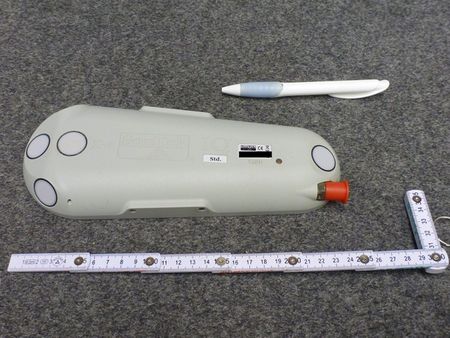Discharge - Velocity profiler (Sontek IQ)
Jump to navigation
Jump to search
The printable version is no longer supported and may have rendering errors. Please update your browser bookmarks and please use the default browser print function instead.
Parameter to be measured:
Discharge (velocity profiles, water stage, temperature)
Method:
ultrasonic Doppler profiling in 4 slant beams, stage measurement via pressure and vertical beam
Equipment:
Sontek IQ device, cable + adaptors (needs external power supply, optional logger)
Advantages:
- continuous monitoring of discharge where not clear h-Q-exists
- useful for conditions of reverse flow and backwater effects
- velocity profiles along 4 beams up to 5 m depth
- small and lightweight
- data storage in device or on external logger
Disadvantages:
- unsuitable for conditions with bedload or siltation
- Velocity measurements are noisy, and in conditions of slow/stagnant water negative biased
- measurements needs movement of particles (or fish!). Below SNR of 10 dB, data seems to be erroneous (e.g. with stagnant water).
- For *relatively* sudden and intense changes in velocity, unrealistic velocity and depth readings may occur.
- depth measurement is prone to error: beams may underestimate (beam interference, fish) or overestimate (multiple path echos). Strangely, depth measurements via pressure are corrected with faulty beam data, not vice versa.
- Per default and IQ Standard, the conversion of beam velocity data to mean xz velocity seems to use some power law, which is faulty in case of unusual velocity profiles.
Fix this by selecting "Recalculate Flow" (works only if all single profile have been recorded, ie. Sontek Plus, see below).
What to watch out for:
- IQ comes in three flavours: Standard, Plus and Pipe (?). The former two seem to be physically identically and vary only in price and the possibilities to interpret the data with the software. With IQ Plus you have the possibility to change settings afterwards, to calculate flow in different ways and to see/extract more data than with the IQ Standard. The IQ Standard can be upgraded to Plus for ~3500 € or with some creativity.
- The configuration file for an IQ Standard can be changed manually with any text editor before the measurement is started. It will have no effect applying the changes in post processing.
- Sensor burial by sedimentation, seems to happen quite quickly. Watch out for warnings through the Status Code.
- maximum water depth differs between Standard, Plus and Pipe
- minimum water depth for Standard/Plus according to manual is 8 cm. We found 10 cm not to be working for our application of the Plus.
Problems/Questions:
- exact usage of the beams for velocity calculation is intransparent; Default setting and IQ Standard seem to use only forward and backward beam.
- Velocity profiles may not be exported because of low water depth (for our application at ca. 35 cm), but are shown within the IQ software.
Price:
3700 / 8000 € for Standard/Plus (Germany, 2013)
Links
Projects that used the above equipment:
Other related web sites:
